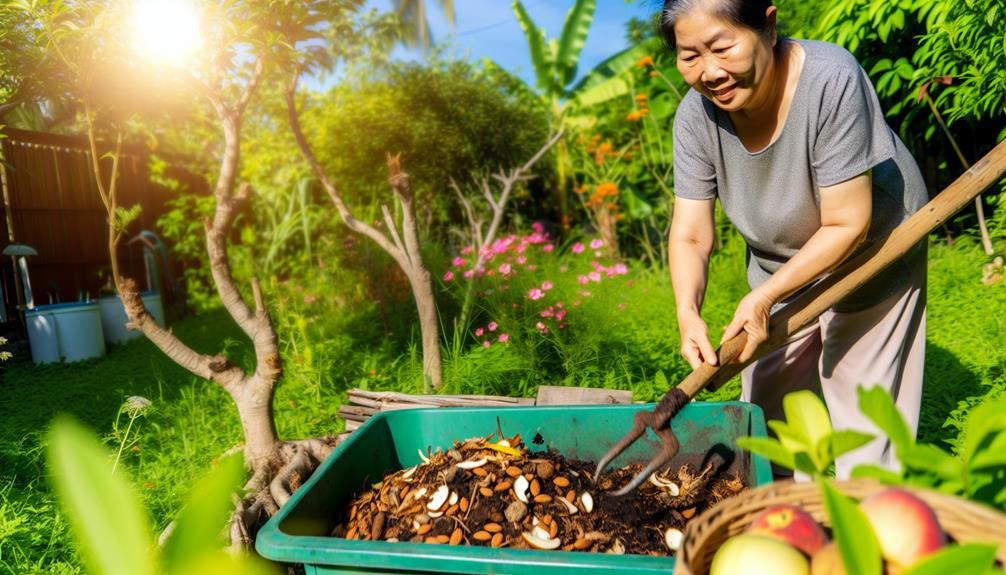

Yes, you can compost almond shells. They add valuable nutrients like potassium and calcium, and improve soil structure. However, due to their tough, woody nature, they decompose slowly. To speed up the process, crush the shells into smaller pieces. Mix them with other compost materials to balance nutrients and maintain moisture.
Regularly turning the compost will also help. Be mindful of potential pest issues by ensuring shells are clean before adding them. By following these steps, you’ll enrich your compost pile effectively. There are additional uses and benefits of almond shells in gardening and beyond.
You might be surprised to learn that almond shells contain several beneficial nutrients despite their tough exterior. Rich in fiber, almond shells can contribute to the organic matter in your compost pile.
They also contain trace amounts of essential minerals like potassium, calcium, and magnesium, which are crucial for plant health. The shells’ fibrous material helps improve soil structure, allowing for better water retention and aeration.
Additionally, almond shells have a slow decomposition rate, providing a steady release of nutrients over time. This gradual breakdown guarantees that your compost remains nutrient-rich for longer periods.
Also Read: Can You Compost Bacon Grease?
Incorporating almond shells into your compost offers numerous advantages that bolster the health and productivity of your garden. First, they add essential nutrients like potassium and calcium, which contribute to plant growth.

Almond shells also improve soil structure by increasing aeration and water retention, ensuring roots get the oxygen and moisture they need. Their fibrous nature aids in the decomposition process, acting as a natural bulking agent and promoting microbial activity.
Additionally, almond shells help reduce waste, making your composting efforts more sustainable. By using these shells, you’re not only enhancing your soil but also contributing to environmental conservation.
Also Read: Can You Compost Bacon?
Despite their benefits, composting almond shells presents a few challenges that gardeners need to address for best results.
First, almond shells are extremely tough and fibrous, making them slow to break down.
Second, their high lignin content can hinder the decomposition process.
Third, they can create an imbalance in your compost pile if not mixed with other materials.
Finally, almond shells may attract pests if not managed properly.
Addressing these challenges effectively will help you make the most of composting almond shells.
To prepare almond shells for composting, start by thoroughly cleaning them to remove any residual salt or oils. Next, crush the shells into smaller pieces to speed up decomposition.
Before adding almond shells to your compost, make sure to thoroughly clean them to remove any residues or contaminants. Cleaning almond shells is straightforward and guarantees you’re not introducing harmful substances into your compost pile.
Here’s how you can do it:
These steps will help you prepare clean almond shells for effective composting.
Crushing almond shells into smaller pieces greatly accelerates their decomposition in your compost pile. Begin by using a hammer or heavy object to break the shells into manageable fragments.
Place the shells in a sturdy bag or container to prevent them from scattering. Alternatively, you can use a mortar and pestle for a more controlled crush.
By reducing the shell size, you increase the surface area exposed to decomposers, speeding up the breakdown process. Remember to wear safety goggles to protect your eyes from flying debris.
Once crushed, the almond shells will integrate more easily with other compost materials, promoting efficient decomposition. This simple preparation step ensures your compost pile remains active and productive.
After crushing the almond shells, mix them with other compost materials to balance the nutrient content and enhance overall decomposition.
You’ll want to combine the shells with both green and brown compost materials. Greens, like fruit and vegetable scraps, provide nitrogen, while browns, such as dried leaves and cardboard, supply carbon.
To guarantee efficient composting, consider the following:
Also Read: Can You Compost Balloon?
When you’re composting almond shells, understanding their decomposition rate is essential. Almond shells naturally break down over months to years, depending on various factors. Environmental conditions like moisture, temperature, and microbial activity can greatly influence this process.
Understanding the natural decomposition rate of almond shells will help you manage your compost pile more effectively. Almond shells decompose slowly, often taking several years to fully break down. This slow rate is due to their hard, woody texture. To better incorporate almond shells into your compost, you might consider breaking them into smaller pieces.
Here are some essential points to keep in mind:
Environmental factors play a significant role in the breakdown of almond shells in a compost pile. Temperature, humidity, and microbial activity are key influencers. Warmer temperatures, ideally between 120-160°F, accelerate decomposition. High humidity levels, around 50-60%, are crucial for microbial activity, which speeds up the breakdown process.
Managing humidity by watering the pile regularly and turning it to maintain aeration is essential. Microbial activity is vital for decomposition. Boosting the microbial community by adding a mix of green (nitrogen-rich) and brown (carbon-rich) materials is recommended.
Almond shells, being high in carbon, can be balanced with green materials like vegetable scraps or grass clippings to enhance the process. Introducing compost starters or a handful of garden soil can also help introduce beneficial microbes to the mix.
How can you guarantee you’re composting almond shells effectively and sustainably?
Start by ensuring they break down efficiently. First, crush the shells into smaller pieces to speed up decomposition.
Next, maintain a balanced compost mix by layering the almond shells with green, nitrogen-rich materials like vegetable scraps.
Regularly aerate your compost pile to promote microbial activity and prevent odors.
Incorporating almond shells with other compost materials can enhance the overall effectiveness of your composting efforts. Almond shells, being high in carbon, should be balanced with nitrogen-rich materials like kitchen scraps and grass clippings.
Layering is key: start with a base of coarse materials, then add alternating layers of almond shells and green waste. This helps maintain proper aeration and moisture levels. Make sure to chop or grind the shells to speed up decomposition.
Regular turning of the compost pile will guarantee even breakdown and prevent any unpleasant odors. By combining almond shells with a variety of organic materials, you’ll create a nutrient-rich compost perfect for enriching your garden soil.
Also Read: DIY Composting Toilet Guide: Build Cheap, Eco-Friendly Now!
Many people mistakenly believe that almond shells take too long to decompose in a compost pile. This misconception can deter you from using them effectively. However, with proper management, almond shells can be a beneficial addition to your compost.

Here are some myths you might’ve heard:
You don’t have to limit almond shells to just composting. They also make great garden mulch, serve as sustainable craft supplies, and even work as an eco-friendly fuel source. Exploring these options can help you make the most of this versatile material.
Sometimes overlooked, almond shells can serve as an excellent garden mulch material, offering both aesthetic and functional benefits. They’re natural, sustainable, and can improve the health of your soil.
By using almond shells as mulch, you can:
To use them effectively, spread a 2-3 inch layer around your plants, ensuring they don’t touch the stems directly. This will maximize the benefits and keep your garden thriving.
Almond shells’ natural texture and durability make them perfect for sustainable craft projects, offering an eco-friendly alternative to synthetic materials.
You can use almond shells to create unique jewelry, such as necklaces and bracelets, by drilling small holes and stringing them together.
They also work well in mosaic art; simply crush the shells into smaller pieces and arrange them into intricate patterns.
For a rustic touch, incorporate them into picture frames or decorative vases.
You can even use whole shells for crafting natural ornaments. To prepare them, clean and dry the shells thoroughly.
Their sturdy nature guarantees your creations will last, making almond shells a versatile and sustainable option for your crafting needs.
In recent years, almond shells have emerged as a promising eco-friendly fuel source for both residential and industrial applications. By opting to use almond shells as fuel, you can contribute to a more sustainable energy future.
Here are some practical benefits:
You can use almond shells in biomass boilers, pellet stoves, or even as barbecue fuel. This versatile option helps reduce waste and promotes a cleaner environment.
To successfully compost almond shells, break them down into smaller pieces for faster decomposition. Mix them with green materials like fruit scraps or grass clippings to balance the carbon-rich shells.
Keep the pile moist and turn it regularly to guarantee even breakdown. While almond shells are tough and take time to compost, they enrich the soil. By following these steps, you can effectively incorporate almond shells into your composting routine.
